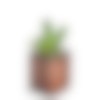All About Office Plants
Some people might tell you that office plants are the perfect addition to any home office space. Maybe this is true, but we find that’s quite up to you. We’re here to help you discover how you really feel about indoor plants, how confident you are with plant growing, and if your dream office environment is a green one.
Benefits of Plants
Well, we wouldn’t exist without them. How’s that for a benefit?
Ask not what plants can do for you. Ask, “how do I bring plants into my office, where they were never meant to be, and keep them healthy and happy?’ It’s a mindset shift that’s foundational to a healthy and successful experience with indoor plants.
As Michelle Slatalla points out in Gardenista’s 10 Things Nobody Tells You About Trendy Houseplants:
“The first rule of having a houseplant is that it would rather be living outdoors in its native environment.”
We’ll return to Gardenista’s wisdom throughout this guide—they help to set reasonable expectations for your plants and they give thorough instructions on how to care for them.
But first let’s talk about why you might want to bring plants into your workspace at all. Those “benefits.”
Ask not what plants can do for you. Ask, “how do I bring plants into my office, where they were never meant to be, and keep them healthy and happy?’ It’s a mindset shift that’s foundational to a healthy and successful experience with indoor plants.
As Michelle Slatalla points out in Gardenista’s 10 Things Nobody Tells You About Trendy Houseplants:
“The first rule of having a houseplant is that it would rather be living outdoors in its native environment.”
We’ll return to Gardenista’s wisdom throughout this guide—they help to set reasonable expectations for your plants and they give thorough instructions on how to care for them.
But first let’s talk about why you might want to bring plants into your workspace at all. Those “benefits.”
For Beauty
There are a lot of lovely plants out there. Gangly ones, dangly ones, crisp ones, stiff ones, dark ones, light ones. In short, you can easily find some plant companions that fit your style and complement your space.

Colibri Plants, Portland, OR
For Health
We don’t mean removing toxins. Because of this NASA study, some claim unqualifiedly that plants remove toxins from the air. That study, though, was conducted in a very controlled, air-tight environment, nothing like the conditions we live and work in. Check out this Atlantic article for more details, but the takeaway is that you’d probably need anywhere from one to ten plants per square foot to begin to remove polluting compounds. And even then there are competing factors. So, maybe don’t count on plants to clean your air.

By health, we mean emotional and mental and environmental health. The living-ness of plants, the sound-absorption qualities, the peaceful color tones, the bright color pops. These things liven your space and break up the abundance of manufactured things, connecting you to the pulse of the outside world. Which, as we noted in our lighting article, is a connection that our bodies rely on.
A curated collection of plants can do a lot to reduce stress, provided they’re easy to care for (by your standards) and fit perfectly into your space.
Also, plants do release oxygen into the air and trap carbon dioxide. Even though they also release carbon dioxide through respiration, it’s still a net gain of oxygen (per the latest research on the matter). Again, you’d really need a lot of plants to produce substantial amounts of O2, but those little extra oxy boosts can’t hurt.
A curated collection of plants can do a lot to reduce stress, provided they’re easy to care for (by your standards) and fit perfectly into your space.
Also, plants do release oxygen into the air and trap carbon dioxide. Even though they also release carbon dioxide through respiration, it’s still a net gain of oxygen (per the latest research on the matter). Again, you’d really need a lot of plants to produce substantial amounts of O2, but those little extra oxy boosts can’t hurt.
For Happiness
You might find a plant, or plants, you really love. A single glance at it brings tears to your eyes and sparks all sorts of electrochemical reactions in your body. That there is reason enough for a plant.

A Sincere Note:
We intentionally didn’t list “increased productivity” as a benefit of home office plants. Yes, you might find yourself more productive and effective as a result of having some greenery around. But out of respect for the quiet power of natural things, we opted not to put those natural things in the service of “productivity.” It’s the same sort of respect we try to bring to the wood we use, the leather, the wool, the natural linoleum, the brass and steel and titanium.
Fun read: Grovemade talks about our Maple and Walnut in the Know Your Woods journal entry.
Fun read: Grovemade talks about our Maple and Walnut in the Know Your Woods journal entry.
Care of Plants
If you’ve decided you want some plants in your workspace, now move to choosing the right plant. Consider: 1) how much work you’re willing to put in to care for them, and 2) what the existing light and humidity conditions are. Maybe that super hip plant you’ve got your eyes on is actually really delicate and dies if you ever take your eyes off it.

Speaking of hip plants, a quick glance at pop plant literature reveals recurring top contenders for indoor plants. Peace Lily. Monstera. Spider Plant. Pothos. ZZ Plant. Rubber Tree. Sago Palm. Various succulents, from cacti to jade plants. Air plants.
Some of those may speak to you, but there is a whole earth of plants out there, many of them lurking in lower-light conditions. That leaves you with a lot of options. But we did promise a decision algorithm, so here it is, beginning with Filter #1...
Some of those may speak to you, but there is a whole earth of plants out there, many of them lurking in lower-light conditions. That leaves you with a lot of options. But we did promise a decision algorithm, so here it is, beginning with Filter #1...


From "My plants are my babies"
To "I just want something nice to look at and water every once in a while."
To "I just want something nice to look at and water every once in a while."
The Commitment Spectrum
Once you’ve identified your location on this spectrum, take yourself to Ecosia (the search engine that plants trees), and find plants that fit the bill. “High maintenance indoor plants,” for example, leads us to The Spruce’s The Most High-Maintenance House Plants. Rounding out the list is the popular Fiddle Leaf Fig, which thrives in rainforest conditions. So, probably not in the “impossible to kill” category. But hey, turning your workspace into a rainforest might be right up your alley!

Dinesh Valke / Flickr / CC BY-SA 2.0
HGTV provides a slideshow with 20 “difficult to grow inside” plants. Calathea, Azalea, Zebra Plant, Boston Fern all make the cut. These plants require fine-tuned conditions and frequent care and attention.

On the other end of the spectrum, we have the low maintenance plants. Like the popular ZZ plant. Orchids have a reputation for being hard to grow, but Gardenista points out that there are many varieties, and gives six flowering options that are a little more amenable to indoor growth.
Here are some other easy-to-find, relatively easy-to-care-for plants that have enjoyed the indoor plant spotlight lately:
Here are some other easy-to-find, relatively easy-to-care-for plants that have enjoyed the indoor plant spotlight lately:
| Common Name | Scientific Name |
|---|---|
| Aloe Vera | Aloe Vera |
| Snake Plant | Dracaena Trifasciata |
| Spider Plant | Chlorophytum Comosum |
| African Violet | Streptocarpus sect. Saintpaulia |
| English Ivy | Hedera Helix |
| Golden Pothos (Devil’s Ivy) | Epipremnum Aureum |
| Philodendron | Philodendron |


From "I work in the bright, energizing glow of direct sunlight for 8 hours of the day"
To "I work in the bunker basement."
To "I work in the bunker basement."
The Light Spectrum
Plants need light. It’s worth taking their light needs seriously. If their care instructions say “6 hours of direct, unfiltered sunlight,” then they probably really need 6 hours of direct unfiltered sunlight.
Again, Gardenista does a roundup of low-light-thriving plants. Asparagus fern, Angel Vine, and Mother in Law’s Tongue can all manage in darker spaces. So if you’re in a basement or a room with few windows, try to find a plant that doesn’t need tons of sun.



From "I need to make sure my plants are pet friendly"
To "My pets pose no threat, and vice versa."
To "My pets pose no threat, and vice versa."
The Toxicity Spectrum
In short, if you have a cat, stay away from true lilies and sago palms. If you have a dog, stay away from sago palms. For a deeper dive and more nuanced look, check out this input from Dr. Tina Wismer, medical director of the American Society for the Prevention of Cruelty to Animals Animal Poison Control Center.

Now your filters are set, your parameters are in place, and you can start to narrow down all those options. We also like the idea of having a theme to guide you in your choosing. This can be anything really. Like: A study in verdant curvilinearity, or Plants of the Pacific Northwest, or Highest-VOC-filtering plants. Or, if you’re like Amanda Gutterman, you go the “5 Houseplants That Changed History” route.
Placement of Plants
Here’s the formula for this one:
(Plant’s Needs) x (Spatial Fluidity) x (Visual Cues) = Where you should put your plant
1. Put your plant’s needs first, taking into account its lighting and temperature needs. If you need to keep your plant in a different room because it needs more light, that could be a nice opportunity to build “plant breaks” into your day. Step away from the desk and check in on your botanical friend.
2. With those restraints in place: which spots feel like they’re lacking something? Where can you put a plant that contributes to the overall flow and feel of your area?
3. Let the lines, curves and colors of your plant play off of the surrounding objects and layout. Maybe you want a tall narrow plant to be right now to your growing collection of bobbleheads. Or a deep, dark green plant to complement the rich colors of your Wayne Thiebaud painting.
(Plant’s Needs) x (Spatial Fluidity) x (Visual Cues) = Where you should put your plant
1. Put your plant’s needs first, taking into account its lighting and temperature needs. If you need to keep your plant in a different room because it needs more light, that could be a nice opportunity to build “plant breaks” into your day. Step away from the desk and check in on your botanical friend.
2. With those restraints in place: which spots feel like they’re lacking something? Where can you put a plant that contributes to the overall flow and feel of your area?
3. Let the lines, curves and colors of your plant play off of the surrounding objects and layout. Maybe you want a tall narrow plant to be right now to your growing collection of bobbleheads. Or a deep, dark green plant to complement the rich colors of your Wayne Thiebaud painting.

"Three Machines" © Wayne Thiebaud, 1963
Let your design wisdom guide you. The nice thing is that if, in two weeks, you feel like you messed it all up, that’s ok! Move it around. It’s your office and you can do what you want to.
In fact, keeping in mind where your natural light source is, you can do just about anything. And if you don’t have any natural light, there are still options for you!
For example, if you sit at a desk with no nearby windows, place a ZZ or Pothos plant on it. If you have an empty corner or flat, open wall, place an asparagus fern in a hanging basket. If you need a little verticality in your space and are wondering, what’s a good tall office plant? Try a Mass Cane plant. Have a big, sun-filled window? That’s a good spot for your jade plant, cacti, or Mother in Law’s Tongue.
This plant diagram from the Spruce shows a tailored plant setup, attending to the particular light needs of each plant.
But no one knows your space like you do! So now it’s time to visualize the area, find the light sources, choose your plants, and get to work!
In fact, keeping in mind where your natural light source is, you can do just about anything. And if you don’t have any natural light, there are still options for you!
For example, if you sit at a desk with no nearby windows, place a ZZ or Pothos plant on it. If you have an empty corner or flat, open wall, place an asparagus fern in a hanging basket. If you need a little verticality in your space and are wondering, what’s a good tall office plant? Try a Mass Cane plant. Have a big, sun-filled window? That’s a good spot for your jade plant, cacti, or Mother in Law’s Tongue.
This plant diagram from the Spruce shows a tailored plant setup, attending to the particular light needs of each plant.
But no one knows your space like you do! So now it’s time to visualize the area, find the light sources, choose your plants, and get to work!
Wood Succulent Planters
Enliven any surface with our hardwood planter. Each is carved from solid walnut or maple with a removable, custom stainless steel liner cup. To accentuate the warmth of the wood, the planter is hand sanded and finished with a vegetable-based oil for a rich, lustrous look. Perfect for all types of miniature flora.























